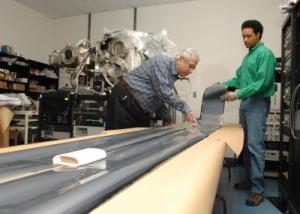Jun 23 2010
The University of Delaware Institute of Energy Conversion (IEC) is part of an industry-academic team that has been awarded $3.8 million from the Defense Advanced Research Projects Agency (DARPA), the research and development office of the U.S. Department of Defense, to demonstrate solar cells that can stand up to battle conditions and environmental extremes.
The research program, "Flexible High-performance Tandem-junction PV Array," under DARPA's Low-Cost Lightweight Portable Photovoltaics (PoP) solicitation, is led by Ascent Solar Technologies, Inc. Headquartered in Thornton, Colo., the company is a developer of flexible thin-film solar modules and identified as ASTI on the NASDAQ.
 Researchers Erten Eser, left, and Shannon Fields work on a large, flexible solar panel at the University of Delaware's Institute of Energy Conversion.
Researchers Erten Eser, left, and Shannon Fields work on a large, flexible solar panel at the University of Delaware's Institute of Energy Conversion.
The funding level for UD's IEC is $647,649 for the initial 18 months of the three-phase program. The entire program is anticipated to continue over the next 54 months.
"The significance of the Low-Cost Lightweight Portable Photovoltaics (PoP) is that it will take thin-film, flexible copper-indium-deselenide based solar cells to the next level of performance in order to meet DARPA's requirements and will accelerate the implementation of thin-film flexible solar cells to commercial and residential markets," said Robert Birkmire, IEC director.
"IEC has been at the forefront of flexible copper-indium-deselinide based solar cells on a plastic substrate for over 20 years and has developed much of the technology that is currently being commercialized," Birkmire noted.
The goal of PoP is to demonstrate low-cost, lightweight phovoltaics (PV) that can not only weather battle conditions and environmental extremes, but also deliver a power conversion efficiency of 20 percent or greater by the end of the program.
The University of Delaware Institute of Energy Conversion is the sole academic partner on the project. The industrial partners include ITN Energy Systems of Littleton, Colo.; Cambrios Technologies Company of Sunnyvale, Calif.; Brewer Science of Rolla, Mo.; and QinetiQ North America-Technology Solutions Group of Boston.
"We are excited that DARPA selected our team for the PoP project," stated Farhad Moghadam, president and CEO of Ascent Solar in a press release issued by the company.
"In order to meet the aggressive goals of performance, capacity, and military toughness, our team has put together a definitive plan that combines our flexible CIGS [copper-indium-gallium-diselenide] production experience and existing MILSTD 810G military product, advanced high-temperature substrates from QinetiQ, the combined expertise in multijunction thin film technology from ASTI and IEC, films for optical and electrical enhancement from Brewer and Cambrios, and enhanced packaging technologies being developed by ITN and ASTI. The outcome of the program dovetails nicely with our existing technology improvement pathway for our flexible thin-film monolithically integrated CIGS-based PV modules for the Department of Defense," Moghadam said.
Source: http://www.udel.edu/